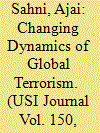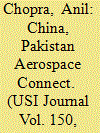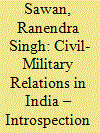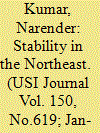|
|
|
Sort Order |
|
|
|
Items / Page
|
|
|
|
|
|
|
| Srl | Item |
| 1 |
ID:
172627


|
|
|
|
|
| Summary/Abstract |
Commentary on terrorism has underestimated the role of sponsoring states and great power destabilisation, giving rise to gross errors of assessment. Mythmaking and a range of distortions have resulted in flawed policies and irrational interventions. Deliberate provocation of hysteria about the ‘rising threat of terrorism’ is contrafactual and has been used as a bogey to justify unilateral interventions by great powers, inflicting appalling human costs. The reality is, global Islamist terrorism is past its ‘half-life’ and is declining. Nevertheless, the circumstances that have animated this, and earlier waves of terrorism, persist and, on many parameters, have worsened, creating the likelihood of future and potentially more disruptive waves of terror.
|
|
|
|
|
|
|
|
|
|
|
|
|
|
|
|
| 2 |
ID:
172628


|
|
|
|
|
| Summary/Abstract |
The JF-17 Thunder fighter aircraft, jointly developed by Pakistan and China, can be considered a show-case of Sino-Pak defence cooperation. Pakistan continues to be China’s strongest ally. After dismemberment of Pakistan and creation of Bangladesh in 1971, Pakistan forged a formal strategic alliance with China in 1972. The China Pakistan economic Corridor (CPEC) remains the ‘crown-jewel’ of China’s Belt and Road Initiative (BRI). Pakistan continues to be a key element of China’s ‘string of pearls’ policy to create sphere of influence around India. For Pakistan, China is a low-cost-high-value deterrent against India. China helped Pakistan build its military-industrial complex, and Pakistan is the biggest purchaser of Chinese weapons. Aerospace has been the lynch-pin of Sino-Pak defence relationship. China helped Pakistan set up the Pakistan Aeronautical Complex (PAC). Pakistan today produces 25 JF-17 a year, and, with help of China, is looking for export markets in competition with India’s Light Combat Aircraft (LCA). Pakistan Air Force (PAF) and Peoples Liberation Army Air Force (PLAAF) regularly conduct Shaheen series of joint air exercises. Close ties between PLAAF and PAF force Indian Air Force (IAF) to cater for a two front war. Pakistan is strong enough to be a spoiler and, in cahoots with China, could pose a substantial threat.
|
|
|
|
|
|
|
|
|
|
|
|
|
|
|
|
| 3 |
ID:
172629


|
|
|
|
|
| Summary/Abstract |
This year’s winning essay examines civil-military relations (CMR) in a historical perspective, leading up to its present status. The essay also identifies crucial areas of civil-military dissonance – both from a military as well as civilian perspective, while critically examining the measures proposed for reformation of higher defence management and strengthening CMR. It prescribes reforms in CMR could be most effectively implemented by a ‘Top-Down Approach’. However, the author proposes a more pragmatic ‘Lateral or Indirect Approach’. It also suggests means of strengthening CMR further in the interest of the nation.
|
|
|
|
|
|
|
|
|
|
|
|
|
|
|
|
| 4 |
ID:
172633


|
|
|
|
|
| Summary/Abstract |
As India was inching towards freedom, the idea of a Crown Colony for the hills of North East (NE) India germinated in the minds of the departing colonial rulers. This article outlines the secret proposal of a British-administrated Crown Colony and the circumstances prevailing in the remote borderlands of India at that point. This Crown Colony would have included all tribal areas of NE India as well as the contagious tribal areas of Burma. As such, most of the tribal areas of the NE, mainly the hills of the province of Assam, were classified as ‘Excluded’ or ‘Partially Excluded Areas’ and the British administrators, having developed an admiration for the tribal people due to their long association, were reluctant to put them under far-away Delhi. Therefore, a Crown Colony, like Singapore, Hong Kong, Aden or Gibraltar, on the eastern periphery of India, consisting of tribal areas from Indian and Burma, ruled by benign and tribal-loving British administrators, was achievable. The idea gained considerable traction in the British bureaucracy, from Delhi to Whitehall, and some support among the tribal people. The plan finally did not succeed but was a near miss. It would have significantly changed the map of India and Burma, and challenged the very idea of a diverse India. The article is a narration of this Crown Colony that never was.
|
|
|
|
|
|
|
|
|
|
|
|
|
|
|
|
| 5 |
ID:
172626


|
|
|
|
|
| Summary/Abstract |
The upwards trajectory of China’s geopolitics in the beginning of 2018 has flattened in the beginning of 2019. This may be the result of the US trade war with China, hiccups in the Belt and Road initiative or the geopolitical churning in Asia. The article illuminates the geopolitical situation and the implications it has for India based upon the author’s travel to Chengdu and Tibet in 2018. The problems that China faces are seen in light of its internal dynamics and a prognosis made keeping in view developments in Tibet. With this background, the author looks at evolving Sino-Indian relations which include a yearning to enhance trade relations while being sceptic about growing strategic proximity between India and the US. The conclusive point made is that the Chinese look at the geopolitical issues purely from the prism of their core interests and seem to have hazy understanding of India’s core interests and concerns. India needs to bridge this gap. Both credible deterrence and deft diplomacy are required for this.
|
|
|
|
|
|
|
|
|
|
|
|
|
|
|
|
| 6 |
ID:
172625


|
|
|
|
|
| Summary/Abstract |
The employment of Unmanned Aerial Vehicles (UAVs) in war and peace is proliferating rapidly. These are being used for offensive and defensive roles, to include surveillance, attack and logistics, besides other complimentary tasks. They are changing equations of conflict as was evident in the attack by a swarm of UAVs on the Aramco oilfields and ferrying of arms across the well fenced Indo-Pak border. Their role in non-contact warfare is increasing. In such a scenario, it becomes imperative that effective counter UAV systems are developed. As of now there is absence of a cogent counter UAV philosophy. Some counter UAV measures are being propagated and marketed in an inorganic and isolated manner. There is a requirement to have an overarching and holistic philosophy to counter the UAV threat. The counter UAV philosophy needs to be based on established threat patterns of adversaries. Thereafter, the vulnerabilities of UAVs have to be exploited to detect and locate them. Finally, one of the many kinetic/non-kinetic methods of their destruction have to be put into action. This article outlines such a philosophy from first principles in the near absence of any literature or reference material of significance on the topic.
|
|
|
|
|
|
|
|
|
|
|
|
|
|
|
|
| 7 |
ID:
172630


|
|
|
|
|
| Summary/Abstract |
Outer space is considered to be final frontier of mankind and the ultimate high ground for war fighters. Outer space, as a domain for the Next Generation Warfare (NGW), has gained substantial prominence in the foresight of militaries over the last two decades. The biggest challenge is to integrate space assets into defence architecture in a seamless fashion.
Role of outer space in national defence and security is significant and expansion of space capabilities is a crucial component of successful military operations. The outer space turf is explored in varied integrated diverse capabilities in offensive and defensive activities.
|
|
|
|
|
|
|
|
|
|
|
|
|
|
|
|
| 8 |
ID:
172632


|
|
|
|
|
| Summary/Abstract |
This essay examines the features of social media platforms (SMPs) and their weaponisation by state and non-state actors alike. The author argues using a host of examples that the age of total war has diminished, if not obliterated completely. A state where every citizen is simultaneously a combatant and a target, a citizen’s war, has been the norm ever since the end of the Cold War. Use of SMPs has exacerbated various fault lines within societies. This has been adequately exploited by actors in Low Intensity Conflict Operations (LICO). Examples such as Hong Kong and Inter–Services Public Relations (ISPR) during the Balakot crisis come to mind. Finally, the author suggests structural, organisational and doctrinal changes by analysing various doctrines, joint and service-specific, to ensure that the Indian Armed Forces are better prepared to take advantage of this extremely potent tool, and use it not only for defence but offensive action too.
|
|
|
|
|
|
|
|
|
|
|
|
|
|
|
|
| 9 |
ID:
172634


|
|
|
|
|
| Summary/Abstract |
Conflict resolution and communication connectivity are key to stability in the North-east for implementation of Act East Policy of India. The developing nexus between drug and weapon cartels, insurgents and rogue intelligence agencies (Inter-Services Intelligence (ISI) of Pakistan and Chinese Intelligence agencies) will be a greater challenge to the state to bring peace and development in the region. In fact, there is an endeavour to reorganise and realign the anti-talk factions so as to maintain instability in the Northeast. The objective is to revive, resuscitate and energise the insurgent groups by coordinating and organising them under umbrella organisations to avoid inter-group clashes and competition. The objectives are clear to keep India engaged within the Northeast and keep it out of Myanmar to deny land connectivity with the ASEAN and South East Asian nations. The instability in the Northeast is now slowly shifting in the hands of external players and the larger strategic objective is to choke development and economic, political and cultural linkages with ASEAN and South East Asia.
|
|
|
|
|
|
|
|
|
|
|
|
|
|
|
|
| 10 |
ID:
172631


|
|
|
|
|
| Summary/Abstract |
Appositely labelled as ‘Blue Gold’ by famous authors Maude Barlow and Tony Clarke, water is slowly becoming more valuable than oil. If the current water consumption and availability trends are to be believed, water is bound to become increasingly salient in geo-political discourse. For India, water issues with neighbouring countries, like China, Pakistan, Nepal and Bangladesh, hold high strategic significance and have the potential to become catalysts for a future conflict. China is an upstream riparian to some of the major rivers flowing into India from Tibet. A sizable length of these rivers are located in Chinese territory and melt water from the Tibetan plateau contributes around 35 to 40 per cent of the total flow in these rivers. With more and more industrialisation, China’s water appetite is likely to surge further and water will get embroiled in the larger geopolitics. With the recent developments on our western borders and sustained covert support to militancy by Pakistan, even the Indus Water Treaty (IWT) is increasingly faced with challenges it wasn’t designed to deal with.
|
|
|
|
|
|
|
|
|
|
|
|
|
|
|
|
|
|
|
|
|